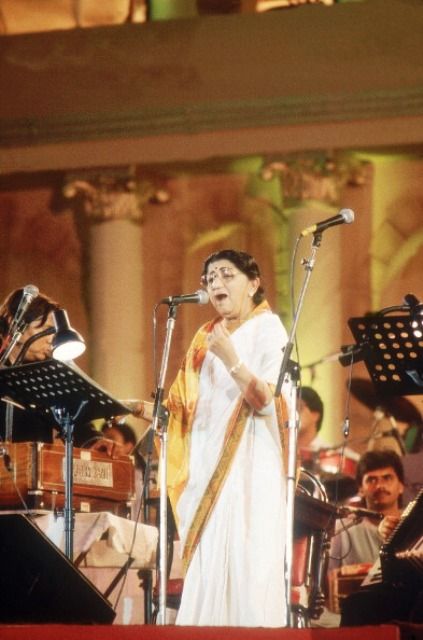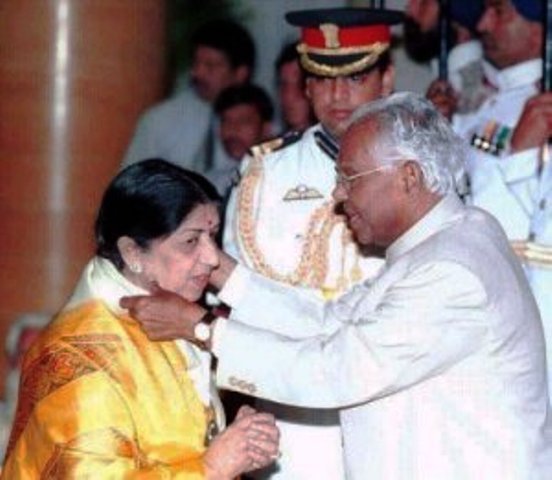
- She was born in a Marathi speaking family to Deenanath Mangeshkar and Shevanti (Shubhamati) in the princely state of Indore, which was a part of Central India Agency (now, Madhya Pradesh).
- Her father was a theatre actor and classical singer.
- Her mother, Shevanti, was Deenanath’s second wife.
- Her father, Deenanath, changed the surname of the family from Hardikar to Mangeshkar; as he wanted to identify his family with their native town, Mangeshi in Goa.
- When Lata was born, she was named Hema, which her parents later renamed as Lata, which was a female character ‘Latika’ in one of her father’s plays ‘BhaawBandhan.’
- Her first public performance was in 1938 at Nutan Theater in Sholapur, where she sang ‘Raag Khambavati’ and two Marathi songs.
- Lata started working as an actress at the age of five in her father’s musical plays (Sangeet Natak) in Marathi.
- She went to school for only one day. It is said that on the very first day of her school, she brought her younger sister, Asha, and started teaching music to other students and when teachers intervened, she was so furious that she stopped going to the school.
- On 9 September 1938, she made her first ‘Shastriya Sangeet’ performance when she accompanied her father to a program at Nutan Sangeet Theatre in Solapur, Maharashtra, where she sang Raag Khambavati. The legendary singer revealed this in a Facebook post that she posted in September 2021.
- When she was 13 years old, her father died of heart disease in 1942, and after her father’s death, one of the close friends of the Mangeshkar family, Master Vinayak (Vinayak Damodar Karnataki), took care of her family and helped her start a career as an actress and singer.
- She sang her first song ‘Naachu Yaa Gade, Khelu Saari Mani Haus Bhaari’ for the Marathi film ‘Kiti Hasaal’ in 1942; however, the song was later dropped from the final cut.
- She sang her debut song ‘Natali Chaitraachi Navalaai’ for the Marathi film ‘Pahili Mangalaa-gaurin’ (1942).
- Her first Hindi song was ‘Mata Ek Sapoot Ki Duniya Badal De Tu’ for the Marathi film ‘Gajaabhaau’ (1943.)
- Lata moved to Mumbai in 1945.
- She played a minor role along with her sister Asha in Master Vinayak’s first Hindi film ‘Badi Maa’ (1945).
- When Ghulam Haidar (music director) introduced Lata to the producer Sashadhar Mukherjee who was making a film ‘Shaheed’ (1948), Mukherjee dismissed Lata’s voice as “too thin;” to this Haidar responded,
- In the coming years, producers and directors would “fall at Lata’s feet” and “beg her” to sing in their movies.”
- Lata’s 1st breakthrough hit song was ‘Dil Mera Toda, Mujhe Kahin Ka Na Chhora’ from the film ‘Majboor’ (1948).
- In an interview, Lata Mangeshkar declared that Ghulam Haidar was her true Godfather who trusted her talent.
- It is said that initially she imitated the acclaimed singer, Noor Jehan, but later, she developed her own singing style.
- When Dilip Kumar (actor) remarked about her Maharashtrian accent; while singing Urdu/Hindi songs, she took lessons in Urdu from an Urdu teacher, Shafi.
- She became wide-popular after the song ‘Aayega Aanewala’ from the movie ‘Mahal’ (1949). The song is considered one of the toughest songs to sing in the music fraternity, and it is said that nobody can sing this song as beautifully as Lata has sung.
- In 1956, her song ‘Rasik Balma’ from the movie ‘Chori Chori’ won the Filmfare Award for the best song. Since Filmfare Awards were introduced in 1958 and also there was no category for Playback Singers, she could not get the award, and after her protest, the category was included in 1958.
- Lata won her first Filmfare Award for the Best Playback Singer for the song ‘Aaja Re Pardesi’ from the movie Madhumati (1958). She monopolized the Filmfare Awards for the Best Playback Female Singer from 1958 to 1966, and it was stopped in 1969 only when she gave up Filmfare Awards in an unusual gesture to promote fresh talents.
- She won her first National Film Award for Best Female Playback Singer for the songs in the film ‘Parichay’ (1972).
- She had the record for the oldest winner (age 61) of the National Film Award in the category of Best Female Playback Singer for the movie ‘Lekin’ (1990).
- Reportedly, she was given slow poison in early 1962, and after that, she was bed-ridden for almost 3 months.
- On 27 January 1963, Lata sang a patriotic song ‘Aye Mere Watan Ke Logo’ against the backdrop of the Sino-Indian war. The song brought Jawaharlal Nehru (the then Prime Minister of India) to tears.
- Lata sang a maximum number of songs (712) for the music director, Laxmikant Pyarelal.
- She composed music for the first time in 1955 for a Marathi film ‘Ram Ram Pavhana.’
- She produced four films- Vadai (Marathi 1953), Jhaanjhar (Hindi 1953), Kanchan (Hindi 1955), and Lekin (1990).
- In 2001, she was awarded India’s highest civilian award ‘Bharat Ratna.’

- The Madhya Pradesh Government and the Maharashtra Government have instituted the ‘Lata Mangeshkar Award’ in 1984 and 1992, respectively.
- She did not like doing makeup.
- In an interview, she revealed that meeting K L Saigal and singing for Dilip Kumar was her unfulfilled desires.
- She had sung more than 50000 songs in 14 different languages.
- In 1999, she was nominated to the Rajya Sabha, but she was reluctant to be inducted into parliament, rather she considered actress Rekha and cricketer Sachin Tendulkar would perform better than her.
- She said,"In fact, I pleaded with those who urged me into Rajya Sabha to let me off. Though I had the highest regard for L. K. Advaniji and Atal Bihari Vajpayeeji, I still do – I am not affiliated to any political party. What did I know about politics? I’m sure Sachin knows more about politics than me.”
- On her 90th birthday in 2019, the Government of India honoured her with the title “Daughter of the Nation” as a tribute to her contribution to Indian Music.
- Lata Mangeshkar was an avid dog lover, and in February 2020, she shared photos of her pet dog “Bittu” on her Facebook account.
- Her last rites were performed at Shivaji Park Crematorium, Mumbai, on 6 February 2022, and Shah Rukh Khan, Sachin Tendulkar, and PM Narendra Modi were a few names who paid their last tributes to the legendary singer at the crematorium. Later, it was declared that a two-day national mourning will be observed for the departed soul.


